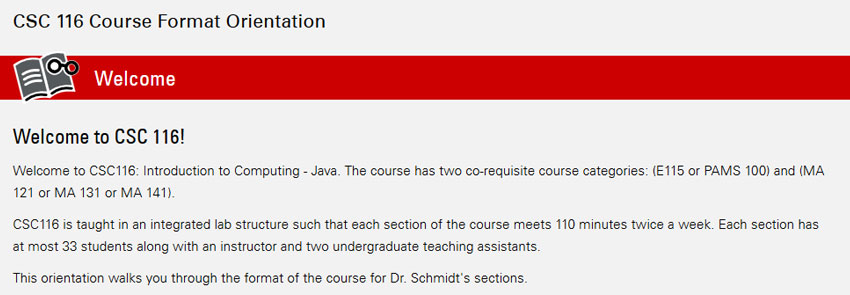
CSC 116: Introduction to Computing – Java
DELTA staff collaborated with Jessica Schmidt to redesign an existing face-to-face course, CSC 116 Introduction to Computing – Java, using the classroom flipping approach to improve student learning outcomes and engagement. Students complete pre-lab learning before class by watching short lecture videos, practicing with small quizzes and performing thinking activities. They spend most of the class time working on group programming exercises that require critical and creative thinking skills. At the end of the semester, students work on a comprehensive exercise in groups to apply the programming concepts and skills learned throughout the semester. They are provided with real-world programming scenarios and step-by-step software development processes, which are designed to prepare them for advanced learning in CSC 216.
Instructional Challenges
- Students felt uncomfortable with watching a number of lecture videos and being assessed by quizzes before coming to class. Some complained that they were teaching themselves. Some still had difficulty with quizzes after watching videos. Some skipped the videos and only did the quizzes.
- Students were learning the pre-lab materials (lecture videos + quizzes) passively, and rarely came up with questions even when they didn’t fully understand the content.
- During in-class exercises, students tended to jump into coding too early, without sufficient analysis of the programming problem. Most of them usually worked on those exercises individually rather than discussing with peers to get different ideas or perspectives.
- Students often felt unprepared for the beginning projects in CSC 216 where they were expected to use the CSC 116 concepts and skills comprehensively to build small applications.
- The blocks on the Moodle main page mixed content topics with homework, projects and exams to create a chronological order, which needed to be simplified and better organized.
Highlights and Solutions
- Pre-Lab Learning Modules: NC State Book and quiz tools were used to design pre-lab learning modules that include a set of small lecture topics and practice quizzes associated with each topic. Thinking activities were designed to help students connect prior and new knowledge and identify questions.
- Course Format Orientation: The orientation to a flipped classroom shows the comparison of the redesigned and traditional CSC 116, explains the before/during/after-class learning expectations, and provides tips for pre-lab and in-class learning. It uses the same format as the pre-labs to help students get familiar with it.
- In-Class Lab Exercises: Students were placed in groups for in-class labs. A Google Doc template was designed to guide the groups through the planning process (problem analysis, solution plan, sharing and extending) before doing any coding.
- Comprehensive Exercise: Moodle resources and Google Docs were designed to provide real-world programming scenarios and guide the software development process. Reflection activities were integrated into each stage of the exercise.
- Moodle Structure and Graphics: The Moodle main page was redesigned by using color-coded banners for different types of blocks (topics, homework, projects, exams, etc.). Key programming concepts were highlighted in each topic banner.
Evaluation Findings
- Students responded positively to the course orientation format and the reorganization of Moodle, feeling that they learned better in the redesigned course as opposed to a traditional lecture-only format.
- Students also reported high engagement. They viewed materials/activities as helping with their learning and left the course with positive perceptions of their ability to program.
- No significant differences were found between grade distributions of the course pre- and post-redesign.
For more information about DELTA services, please contact LearnTech.